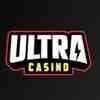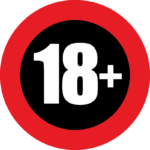What exactly is Rake?
The tiered commission collected by a casino to cover its running costs is referred to as rake. In tournaments, rake is collected as part of the buy-in fee, while in cash games, rake is collected by the dealer dropping a portion of each pot.
If you've ever played cash game poker in a casino, you've most likely noticed the dealer taking chips out of the pot during most hands — those chips are the rake.
To express the obvious, more rake isn't always better.
How Rake Is Collected?
The following are the three most prevalent rake collection methods used by cardroom (in order of most to least popular):
1. Rake the pots
Pot rake is the most prevalent type of collecting, with each hand holding 2.5 percent to 10% of the pot, usually up to a predetermined maximum amount. Some card rooms, on the other hand, take a fixed amount of rake regardless of pot size.
Because some cardrooms do not charge rake until the flip is dealt, raising preflop and taking down the blinds will earn you the entire pot. This is referred as as “no flip, no drop.”
2. Time Recording
A predetermined cost collected (usually) every half-hour throughout the game is known as time collection (sometimes “timed rake” or “table charge”). There are two ways to collect this type of rake:
- Each player is charged a certain amount of time.
- A specified sum is collected from the first pot over a set period of time.
Higher limit games ($10–$20 and up) are more likely to have time rakes.
3. Drop Dead
On each hand, the player in that position places a specified amount of rake on the dealer button, which the dealer collects before any cards are delivered.
Note: The rest of this article is an in-depth look at how to adjust to rake. Check out How to Play Strip Poker That Will Help Your Game if you want to learn more about the fundamentals of video poker strategy.
What Role Should Rake Play in Your Decisions?
Simply put, having a higher rake reduces your EV (Expected Value).
What impact does this have on your decisions? In a nutshell, a higher rake encourages you to play tighter poker.
As a result, all of those marginal postflop calls are now folds. Furthermore, since those marginal open-raises, calls, and 3-bets rely on those marginal value bets, bluffs, and calls to be profitable, this has an impact on preflop ranges.
As a result, you'll need to tighten up your preflop and postflop play.
What Situations Are Affected by Poker Rake the Most?
In high-raked games, there are two common positions that necessitate significant adjustments: calling from the large blind and 3-betting. Moving ahead, we'll concentrate solely on these two areas.
Defending Ranges for the Blind
We'll go through how to develop a solid big blind defend range against any raise size in this part.
You may then duplicate this method to create your own ranges according to on your game's rake structure.
Let's take a look at an example hand where the flop is dealt with a $5 capped rake. (Unfortunately, this is a standard rake structure for live card rooms.)
9-Handed at a local casino for $1/$2. Effective Stacks are worth $200.
With two cards and five folds, Hero is in the BB. CO increases by twofold to $8. Hero…?
Let's determine what Hero's defence range should be.
The procedure begins with the pot odds he is receiving (learn how to calculate pot odds here). To play for a pot of $12, Hero would need to call $6 (CO's $8 raise + the dead blinds $3 + Hero's $6 call – $5 rake):
Pot Odds = $6 / $12 = 0.5 = 50% raw equity is required.
Hero will not be able to realise all of this raw equity because he may be forced to fold before the river or fold the best hand. When defending, keep this in mind: depending on the hand, you may need a little more or a little less than 50 percent equity. We also talked about How to win double double bonus poker.
A Few Thoughts on Equity Realization
Every hand perceives equity in a unique way.
The most equity is realized by hands that are powerful, connected, and/or suited – think AA, AQo, or JTs. These hands frequently overestimate their equity – in the case above, they may profitably call with less than 50% equity.
Disconnected and/or offsuit hands, such as A2o or Q7o, have the least equity. These hands nearly usually underestimate their equity – to call profitably in the case above, they'd need more than 50% equity.
When it comes to equity realization, position and player talent are also important factors. Players who play in position gain more equity than players who play out of position. Because the pro will play better postflop, a veteran pro will gain more equity than a rookie player.
If your hand is a toss-up in terms of raw equity, you should most likely:
- If you have a solid hand with decent playability or believe you have a large postflop advantage, call.
- If you have a weak hand or are unsure about your advantage over your opponent, fold.
If neither of the other options feels right with your hand, try a 3-bet. That way, you'll get experience more quickly.
With that in mind, let's take a look at how all of Hero's possible hands stack up against the CO's anticipated raising range:

The numbers under each hand represent that hand’s equity versus the other range.
CO's opening range is shown on the left. You can see how much equity each hand has against CO's opening range on the right.
Let's figure out how much equity Hero would need to defend if there was no rake before I show you the hands Hero should defend.
$6 / $8 (CO's bet) + $9 (our call + the dead blinds) = pot odds
Pot odds = $6 / $17 = 0.35 -> raw equity requirement of 35 percent
The disparity is astounding! The difference between the two is 50% vs. 35%. Let's look at how Hero's defense range differs with and without rake (I removed the borderline and unplayable cards that are unlikely to generate enough equity):
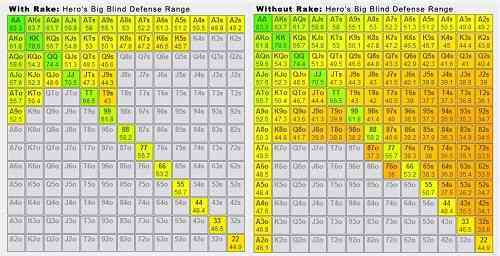
The numbers under each hand represent that hand’s equity versus the cutoff’s raising range,
CO's opening range is shown on the left. You can see how much equity each hand has against CO's opening range on the right.
Let's figure out how much equity Hero would need to defend if there was no rake before I show you the hands Hero should defend.
$6 / $8 (CO's bet) + $9 (our call + the dead blinds) = pot odds
Pot odds = $6 / $17 = 0.35 -> raw equity requirement of 35 percent
The disparity is astounding! The difference between the two is 50% vs. 35%. Let's look at how Hero's defense range differs with and without rake (I removed the borderline and unplayable cards that are unlikely to generate enough equity):
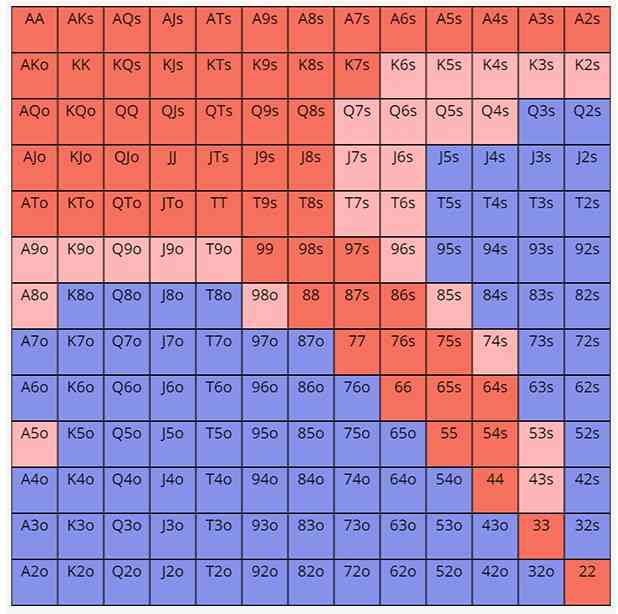
Default cutoff raising range from the Upswing Lab (Red = Raise, Pink = Optional Raise, Blue = Fold)
We'll suppose the cutoff raises with all of the optional hands in this case.
Assume the button employs the Lab's recommended 3-betting range for live games.
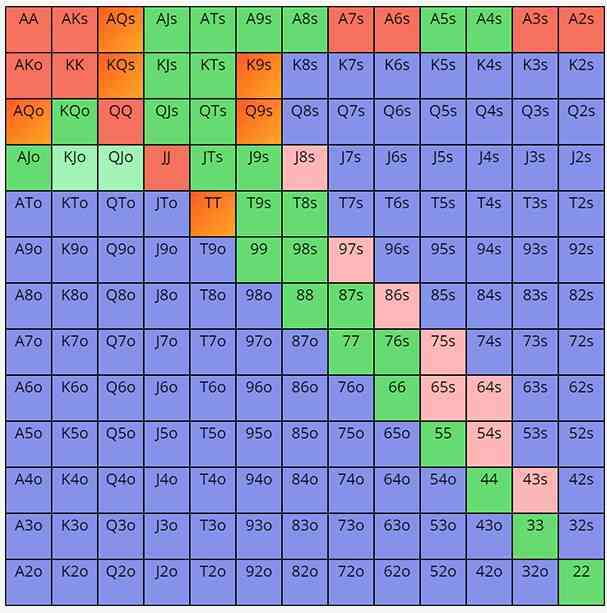
Default button vs cutoff range from the Upswing Lab (Red = 3-Bet, Pink = Optional 3-Bet, Orange = 3-Bet or Call, Green = Call, Blue = Fold)
The button 3-bets only the red and orange hands, we'll presume.
Note: If you'd want access to our whole library of preflop range charts, go here. When you join the Upswing Lab, you'll get access to 259 preflop charts for online cash games, live cash games, and tournaments.
The procedure is fairly similar to that of the preceding section. We'll start by calculating Hero's pot odds:
$12 (our call) + $6 (our raise) + $18 (our opponent's 3-bet) + $3 (dead blinds) – $5 (pot odds) (rake)
Pot odds = $12 / $34 = 0.35 = raw equity requirement of 35 percent
The calculation would be as follows if there was no rake:
$12 / $18 + $18 + $3 / $18 + $18 + $3 / $18 + $18 + $3 / $18 +
Pot odds = $12 / $39 = 0.30 = 30% raw equity is required.
As you can see, the equity disparity is not as significant here. This is due to the fact that the rake is the same price ($5) as the pot. In the previous instance, $5 was removed from a $17 pot (29.4% of the pot), but in this example, $5 is taken from $37 (13.5%) of the pot.
Let's take a look at how our range should look in each instance (again, I've removed the borderline and unplayable hands that aren't likely to generate enough equity):
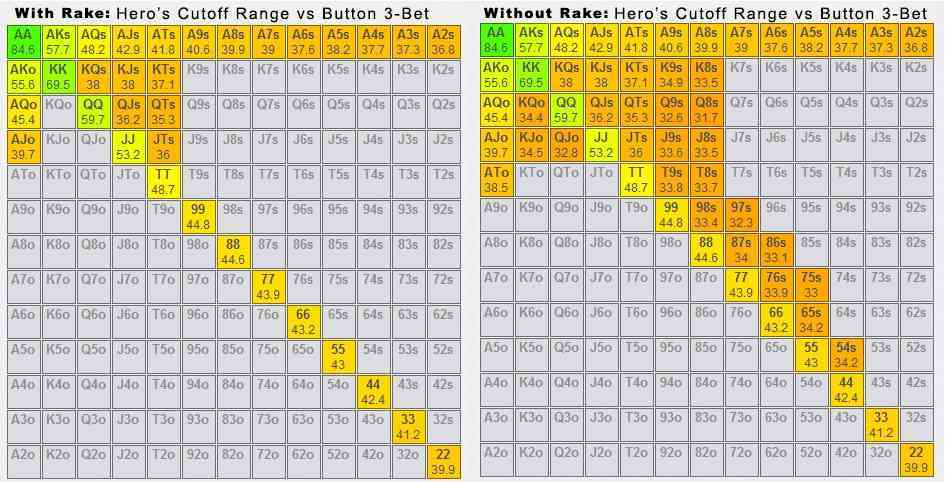
Conclusion
The rake in poker has a significant impact on how you should play. If you want to crush as much as possible, you must consider it and alter your strategy.
If you play online, you can use the same procedure to determine how much rake should affect your game ranges. Look up the rake structure of the site you're playing on and enter the figures. The resulting ranges won't be as narrow as the ones above, but I'm sure you'll be amazed by how much raking affects online results. We also talked about How Casinos make money in Poker and how to host poker home games? so make sure to give it a read too.
If you're a live poker player, you now know how much rake to factor into your preflop ranges.
Is this article's rake-adjusted range tighter or looser than you expected?
Please let me know in the comments section below.
Grinders, best of luck!
